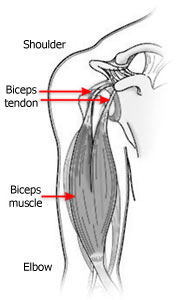Biceps Tendonitis –
A Cause of Shoulder Pain
 Tendons are stronger, resilient structures that attach muscle to bone throughout the body. Tendons are subject to strong pulling forces as they attach muscle to bone. Overuse or repetitive use of muscles and tendons, can cause strain on these structures. With repetitive use, tendons can develop micro tears and inflammation resulting in tendonitis. Left untreated, the inflammation continues and scar tissue develops, making the tendon less pliable and not as strong. The biceps tendon connects the large upper arm biceps muscle to the shoulder girdle. With repetitive use, such as in weight lifting or racquet sports, this tendon can become overstressed, resulting in a sprain type injury. With further activity, inflammation develops resulting in the painful condition of biceps tendonitis. The tendon is subject to normal wear and tear of aging as well. It can become compromised, without inflammation, just as a normal process of aging. Diagnosis is not difficult. Your doctor will exam your shoulder doing various pushing and pulling tests on the arm as well as palpation of the shoulder area over the head of the humerus. Flexing the arm with a light weight will frequently reproduce the pain. If you are suffering from more severe shoulder pain, x-rays to look for arthritis changes and an MRI may be necessary to look for other causes of shoulder pain, such as a rotator cuff tear.
Tendons are stronger, resilient structures that attach muscle to bone throughout the body. Tendons are subject to strong pulling forces as they attach muscle to bone. Overuse or repetitive use of muscles and tendons, can cause strain on these structures. With repetitive use, tendons can develop micro tears and inflammation resulting in tendonitis. Left untreated, the inflammation continues and scar tissue develops, making the tendon less pliable and not as strong. The biceps tendon connects the large upper arm biceps muscle to the shoulder girdle. With repetitive use, such as in weight lifting or racquet sports, this tendon can become overstressed, resulting in a sprain type injury. With further activity, inflammation develops resulting in the painful condition of biceps tendonitis. The tendon is subject to normal wear and tear of aging as well. It can become compromised, without inflammation, just as a normal process of aging. Diagnosis is not difficult. Your doctor will exam your shoulder doing various pushing and pulling tests on the arm as well as palpation of the shoulder area over the head of the humerus. Flexing the arm with a light weight will frequently reproduce the pain. If you are suffering from more severe shoulder pain, x-rays to look for arthritis changes and an MRI may be necessary to look for other causes of shoulder pain, such as a rotator cuff tear.
Treatment usually consists of rest of the arm and avoiding activities that involve overhead arm lifting. Anti-inflammatory agents such as ibuprofen (Motrin, Advil) or naproxen (Aleve) may be of benefit. Icing the area of soreness can help as can switching exercise routines to avoid raising the arm overhead. A course of physical therapy can also be of benefit, involving various therapeutic modalities and shoulder rehabilitation with strengthening. Occasionally, if the shoulder pain is severe, a cortisone injection may relieve the pain but will not heal the tendon injury. It is preferable to avoid surgery for this condition unless there is a severe impingement or entrapment of the tendon.
Platelet rich plasma therapy offers an excellent opportunity for patients to get not only pain relief but healing of their biceps tendonopathy. The tender area(s) of the biceps tendon are identified. Local anesthesia is administered and the platelet rich plasma is injected and “peppered” around the injured area of the biceps tendon. The PRP is then activated with thrombin and a healing graft is formed over the injured tendon. As will all PRP treatments, powerful bioactive proteins go to work, first by release of the contents of the platelets followed by recruitment of the vast healing components of the blood system. Fibrinocytes move in to lay down the matrix that new collagen fibers can be attached. Stem cells eventually migrate into the area and differentiate into new tendon tissue. Remodeling then occurs and the result is a healed, stronger, pain-free tendon. There may be an initial “flare” of inflammation the first week after PRP. This is a normal part of the healing process. If there is discomfort with this, wrapped ice packs and Tylenol products may be used. It is important not to use anti-inflammatory agents, even aspirin, during the first six weeks after the PRP graft is injected. This is the time that active healing is occurring. If you have any type of shoulder pain, ask your doctor if you may benefit from PRP therapy.
